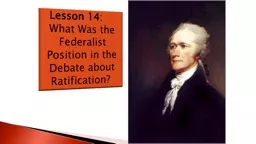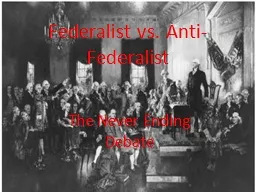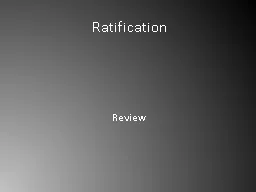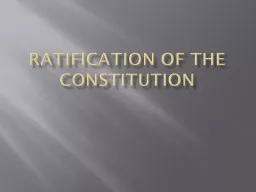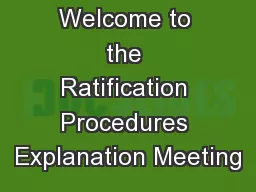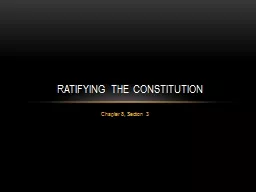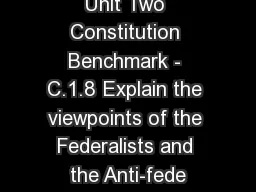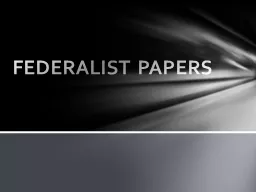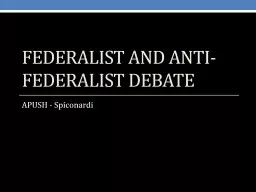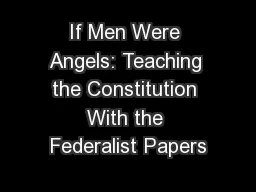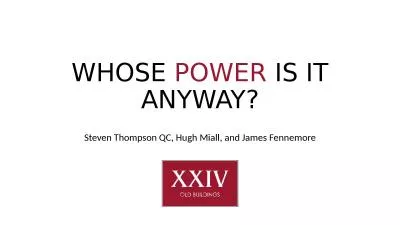PPT-Lesson 14 : What Was the Federalist Position in the Debate about Ratification?
Author : karlyn-bohler | Published Date : 2018-03-08
Those who supported ratification which created a stronger government called themselves Federalists This lesson describes the arguments and strategies Federalists
Presentation Embed Code
Download Presentation
Download Presentation The PPT/PDF document "Lesson 14 : What Was the Federal..." is the property of its rightful owner. Permission is granted to download and print the materials on this website for personal, non-commercial use only, and to display it on your personal computer provided you do not modify the materials and that you retain all copyright notices contained in the materials. By downloading content from our website, you accept the terms of this agreement.
Lesson 14 : What Was the Federalist Position in the Debate about Ratification? : Transcript
Those who supported ratification which created a stronger government called themselves Federalists This lesson describes the arguments and strategies Federalists used to win support for the Constitution. Used for presidential elections. Framers had concerns that voters wouldn’t make informed decisions. Each state selects electors equal in number to its congressional representation. Electors vote twice: once for president, once for vice president. The Never Ending Debate. The Ratification Process. The drafting of the new United States Constitution was only the beginning of the process to make it the law of the land. In order for this to happen, at least nine of the thirteen states would have to ratify the Constitution. The debate over ratification would split the political leaders of the time. People who supported ratification of the Constitution were Federalists, and those who opposed the new Constitution were Anti-Federalists. The debate over ratification of the Constitution would take place on the pages of the many newspapers and pamphlets that circulated in the country.. Review. Terms. Ratify – to give formal approval. Censure – to express disapproval. Dissent – to disagree or withhold approval. Successor – person or thing that replaces or follows another.. Reviewing Social Studies Skills. 9/13 States. Needed to ratify(pass) the Constitution. Irregular?. Federalism. A system of government in which power is divided between a central government and several regional governments(states).. Federalists v. Anti-federalists. @ July 3, . 2015. Constitutional Principles. Lesson Plan – . J.Quiñones. Theme:. . Federalism & Gun Control. Please turn cell phones off or to silent.. A ringing cell phone is a $5.00 contribution to the NEA Children’s Fund.. Legal Responsibility. Union negotiates the contract for all members of the bargaining unit. A Debate over Ratification. Who were the Federalists?. supported . the . Constitution and a strong national government. Federalists . included. were . James . Madison. , . Alexander . Hamilton. , and . Ratifying the Constitution. Key Terms. Federalism. – a system of government where power is shared among the central (or federal) government and the states. Federalists. – supporters of the Constitution. Terms to add to your . vocab. rings. Ratify . – formally approving something (The rat says yea!). Bill of Rights - . the first ten amendments to the U.S. Constitution, establishing rights and protections for American citizens. Written by James Madison, Alexander Hamilton, and John Jay. Published under the name . Publius. . . Intent. : To combat opposition against the constitution. . Ultimate Goal. : Ratify constitution . APUSH - Spiconardi. All communities divide themselves into the few and the many. The first are the rich and wellborn, the other the mass of the people…The people are turbulent and changing; they seldom judge or determine right. Give therefore to the first class a distinct, permanent share in the government. They will check the unsteadiness of the second, and as they cannot receive any advantage by a change, they therefore will ever maintain good government.. Presenters: Damon . Huss and Pam . Jenning. . Poll Question #1. What is the main method you use to teach about the . framing. of the U.S. Constitution?. a. I have students research a project about the Constitutional Convention of 1787 and the history of ratification.. The Articles of Confederation. The Confederation Government. The Critical Period- after ratification during Revolution.. No executive branch to oversee laws.. No power to tax. States had to donate or be willing to give the government money.. Steven Thompson QC, Hugh Miall, and James Fennemore. Improper exercise of powers: the company context. “…. if directors do acts, as they do every day, especially in private companies, which, perhaps because there is no quorum, or because their appointment was defective, or because sometimes there are no directors properly appointed at all, or because they are actuated by improper motives, they go on doing for years, carrying on the business of the company in the way in which, if properly constituted, they should carry it on, and then they find that everything has been so to speak wrongly done because it was not done by a proper board,…”.
Download Document
Here is the link to download the presentation.
"Lesson 14 : What Was the Federalist Position in the Debate about Ratification? "The content belongs to its owner. You may download and print it for personal use, without modification, and keep all copyright notices. By downloading, you agree to these terms.
Related Documents

